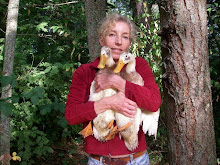It all started with my search for the perfect hat. I started fiddling with the creation of my perfect winter hat.
But almost at the beginning, I took a detour. I started knitting a hat that I knew I would never wear in public but I recognized elements that I would want to keep and combine with other features.
I grabbed some Noro Kereyon off the shelves of my LYS and began knitting. I fell in love with the gradual color changes and thought that a hat worked in sections and then sewed together would shows these off to their best advantage.


I really love the hat and the yarn! I wear it around the house as a kind of comfort wrap.
I got the urge to make yarn with large color repeats. Blocks of color rather than stripes or dots. I considered the possibility of using low twist singles as in the Kureyon I used for the hat.
And then I decided to take a class at Weaving Works on Navajo Plying. The class was short but so amazingly good. The teacher, Shirley Shaw had me successfully navajo plying within minutes. I am hooked.
Navajo plying is a technique in which one can make a "3 ply" yarn from a single bobbin of spun fiber. This makes it possible to get a round yarn that is perfect for knitting and at the same time preserve the color sequences present in the dyed fiber.
Whether it is actually a plied yarn is open to debate. I honestly don't care if you call it a 3 ply or chained single, I'm a convert.
Combining my new skill with a new dyeing method, I'm going a bit wild, spinning hours and hours.
I was so anxious to try the new methods that I was very haphazard with the colors I used.

The black (which was supposed to be gray) was too much so I eliminated it from the roving and spun up about 100 yards and then knitted a sample swatch.
Very bright colors but okay in the right article....maybe a young child's hat.

The initial plying resulted in a slightly underplied yarn. Although I had been told that you can't add additional plying twist to navajo plied yarn, I had to find out for sure if I could. And it worked! I fed it through the wheel again putting in a little more twist. All is well and it's drying outside right now. The only difference I may have noticed (and am not completely sure if this is true) was a slightly more obvious bump where the yarn joins.
When it's dried, I plan on making a child's version of the sectional cap.
The hurried dyeing yielded another roving.

I couldn't wait to spin up the first half of it. I haven't had a chance to swatch it yet. I fear that the turquoise block of color might be a little longer than is ideal.
For the time being, I'll just continue to dye, spin and knit sample swatches in order to get an idea of what will work well. It's a lot of fun!

I've also been doing some pretty sober spinning. I dug into my stash and pulled out some Brown Sheep rejects I bought from Carol Lee at Sheep Shed Studio. They are making a lovely 3 ply yarn though I doubt I'll get more than 450 yards of this color. Luckily I have some gray and blue. The one below is a lovely plum.























